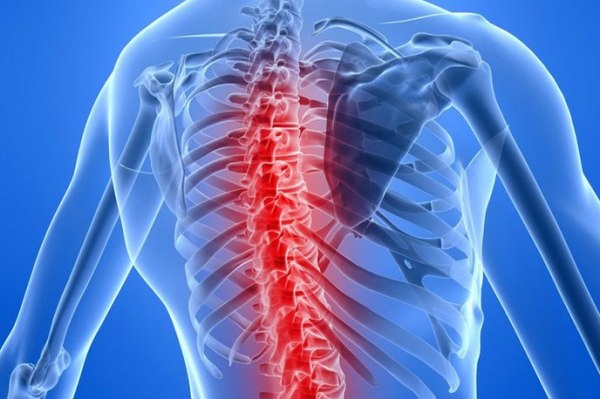Tabes dorsalis develops in less than 5 per cent of patients with untreated syphilis, and symptoms usually become manifest 10 to 20 years after the primary infection. Rarely, there is a latent period of 30 or more years. Men are more often affected than women. Dysfunction of affected posterior roots accrues slowly, and symptoms develop insidiously. Impaired joint position sense frequently results in stumbling and difficulty in walking, especially in the dark when visual compensation is imperfect. As the disease progresses, this sensory ataxia worsens, and a broad-based gait is assumed. Profound hypotonia, secondary to a lack of modulation of muscle tension by afferent fibers, is expressed frequently in a slapping gait.
Paresthesias usually appear early in the disease but may be ignored by the patient until the appearance of lightning pains, These pains are characteristic of tabes dorsalis but are in no way specific, because they occur in other diseases affecting dorsal roots, e.g., diabetic neuropathy. Lightning pains develop in at least 75 per cent of patients and may appear in any area of the body, although they are most common in the lower extremities. Some patients insist that they are more troublesome when the barometric pressure is low.
They may be described as sharp, burning, or aching. However, sharp jabs of pain are characteristic. These may be mild or excruciating, and frequently flit from one region to another. At times they are so transitory that by the time the patient has made the natural move to rub or massage the involved part, pain has disappeared. For a period of hours or days one spot will seem particularly vulnerable, but then the site of attack shifts to another place. Involvement of thoracoabdominal nerve roots gives rise to visceral pains (gastric or visceral crises), which may simulate intrinsic visceral disease and may lead to unnecessary surgery; in one series an estimated 25 per cent of tabetic patients had undergone operation for tabetic pain.
The converse is also true: on rare occasions visceral pain has been ascribed to tabes dorsalis and sup- purative appendicitis, or a ruptured peptic ulcer has gone undiagnosed. As the disease advances, pain sensa- tion may be so dulled that recurrent trauma is unnoticed by the patient and indolent ulcers of the skin develop; the toes and balls of the feet are especially vulnerable. Weight-bearing joints and adjacent bone, deprived of pain sensation, are destroyed by the constant trauma of use in 5 to 10 per cent oftabetic patients (Charcot joints.
Unless general paresis coexists, as it does in a small percentage of cases (taboparesis), tabetic patients are mentally normal. Optic atrophy complicates tabes dor- salis in about 10 per cent of cases or occurs as an isolated disorder. Pupillary abnormalities, including meiosis, irregularity, poor responsiveness to light and mydriatics, but retained reaction in accommodation (Argyll Robert- son pupils), are present in most cases of tabes dorsalis. Involvement of other oculomotor functions is occasionally seen.
Hypotonia, ataxia, and broad-based gait can usually be demonstrated. Affection of the sensory arc of the myotatic reflexes accounts for the greatly diminished or absent stretch reflexes. The Achilles reflex is affected most constantly. The plantar responses are normal in most cases of uncomplicated tabes dorsalis. Loss or diminution of position and vibratory sensation is found in every case. Increased swaying when the eyes are closed and the patient is standing with feet together (Rom- berg’s sign) results from the impaired position sense.
Variable degrees of hypesthesia and hypalgesia in a root distribution can be anticipated but may be difficult to plot. Isolated areas of hypalgesia (Hitzig zones) are sometimes föund. Delayed perception of a pain stimulus (from one to several seconds) often can be demonstrated. Impaired deep pain sensation may account for a dra- matic lack of responsiveness to squeezing of the Achilles tendon or testicles. Because of involvement of sacral nerve roots, functions of the urinary bladder and bowel are impaired in up to one third of cases; overflow incontinence and constipation develop. Impotence is a major complaint in the male.
Characteristically a cystornetrogram shows an absence of, or reduction in, the normal muscular contractions of the bladder in response to filling; the patient may be unaware ofa volume in excess of 500 ml. Hydronephrosis and pyogenic infection are common complications of a hypotonic bladder. Early in the course of tabes dorsalis, the serologic tests for syphilis are, as a rule, strongly positive.
The cerebro spinal fluid may reflect the meningeal inflammatory process with pleocytosis, an elevated total protein, and a positive reagin test. Late in the disease, especially after some antisyphilitic treatment, the serologic tests may be negative (in 25 to 50 per cent of cases), and even the cerebrospinal fluid is negative in up to 20 per cent of cases.
Tabes Dorsalis Treatment
The course of tabes dorsalis is unpredictable, and the response to antisyphilitic therapy is variable. In general, patients who have had symptoms for a few months or at the most a few years, with significant cerebrospinal fluid abnormalities and no prior therapy, are most likely to improve with treatment.
Patients with far-advanced disease and sovere degeneration of dorsal roots and who suffer from the painful complications will not benefit significantly from antisyphilitic therapy. At least partial relief of pain may be achieved by analgesics, but when narcotics are used the risk of addiction is significant. Recently, some benefit has been reported with diphenyl- hydantoin ‘Dilantin) treatment (200 mg per square meter per day). Recourse to spinal cordotomy and other surgical measures to relieve pain should be deferred until all medical measures have failed. Urologic assis- tance may be required to deal effectively with the tabetic uropathies, and surgery may be required for management of penetrating ulcers of the skin and Charcot joints.

